From a region without penitentiaries to a zone of mass incarceration
Toward a regional historical analysis of Latin American prisons
DOI:
https://doi.org/10.62120/mch.8.83Keywords:
latin american history, penitenciary, jailAbstract
In this article, we address the process by which Latin America went from being a region without penitentiaries to becoming one of the main areas of mass incarceration. In the first part, we present the survival of colonial legal culture in the period prior to regional integration into the global market. In the second section, we analyze the construction of the first penitentiaries in capital cities and the spaces of confinement in the "interiors" between 1850 and 1950. In the third part, we study the processes of construction of legal systems for the enforcement of criminal offenses, the role of the United Nations and military dictatorships, the return of democracy, and penal populism between 1950 and the present.
References
Aguirre, C. 2007. “Prisons and prisoners in modernising Latin America (1800-1940)” en Dikötter, F. y Brown, I. (Eds.), Cultures of Confinement. A History of the Prison in Africa, Asia, and Latin America, Ithaca, Cornell University Press.
Barros Leal, C. (2004), “La ejecución penal en América Latina y el Caribe: Realidad y desafíos”, Derecho y Cambio Social, Año 1, Número 1.
Caimari, L. 2004. Apenas un delincuente. Apenas un delincuente. Crimen, castigo y cultura en la Argentina, 1880-1955, Buenos Aires, Siglo XXI.
Carranza, E. 2012. “Situación penitenciaria en América Latina y el Caribe ¿Qué hacer?”, Anuario de Derechos Humanos, número 8.
Cesano, D. 2011. La política penitenciaria durante el primer peronismo (1946 -1955) : humanización, clima ideológico e imaginarios, Córdoba, Brujas.
Cesano, D.; Núñez, J.; González Alvo, L. Eds. 2019. Historia de las prisiones sudamericanas. Entre experiencias locales e historia comparada (siglos XIX y XX).Tucumán: Humanitas.
Evans, R. 1982. The Fabrication of Virtue: English Prison Architecture. 1750-1840, Cambridge, Cambridge University Press.
Fessler, D. 2012. Derecho penal y castigo en Uruguay (1878-1907), Montevideo, Universidad de la República.
Fessler, D. 2022. Delito y castigo en Uruguay (1907-1934). Montevideo, Fundación de Cultura Universitaria.
Fuchs, M. y González Postigo, L. Dir. 2021. Sistemas Penitenciarios y Ejecución Penal en América Latina. Una mirada regional y opciones
de abordaje, Valencia: Tirant,
García Basalo, A. 2013. “¿Un panóptico en Buenos Aires? La primera penitenciaria proyectada en Sudamérica”, Épocas. USAL, número 8.
García Basalo, A. 2017. Para seguridad y no para castigo. Origen y evolución de la arquitectura penitenciaria provincial argentina (1853-1922), Tucumán, INIHLEP.
García Basalo, J. 1977. “La codificación penitenciaria en América Latina”, Revista Penal y Penitenciaria, número 139.
González Alvo, L. y Franco Ferreira, D. (Inédito). “¿Una tercera reforma penitenciaria? Los Institutos Penales Agrícolas del estado de São Paulo (Brasil, 1940-1970)”.
Hathazy, P. and Müller, M. 2015. “The rebirth of the prison in Latin America: determinants, regimes and social effects”, Crime, Law and Social Change, número 65.
Hathazy, P. and Müller, M. 2016. “The crisis of detention and the politics of denial in Latin America”, International Review of the Red Cross, número 903.
Iñesta Pastor, E. 2003. “La proyección hispanoamericana del Código Penal Español de 1848", XIII Congreso del Instituto Internacional de Historia del Derecho Indiano, San Juan, pp. 493-520.
Jaitman, L. Ed. 2017. The costs of crime and violence: New evidence and insights in Latin America and the Caribbean, Washington, Inter-American Development Bank.
León León, M. 2003. Encierro y corrección. La configuración de un sistema de prisiones en Chile (1800-1911), Santiago, Universidad Central de Chile.
Levaggi, A. 1978. Historia del derecho penal argentino, Buenos Aires, Perrot.
Levaggi, A. 2002. Las cárceles argentinas de antaño (siglos XVIII y XIX). Teoría y realidad, Buenos Aires: Ad-Hoc.
Padilla Arroyo, A. 1993. “Pobres y criminales. Beneficencia y reforma penitenciaria en el siglo XIX en México” en Secuencia, n.27, p. 43-70 [En línea].
Padilla Arroyo, A. 2001. De Belem a Lecumberri. Pensamiento social y penal en el México decimonónico, México, Archivo General de la Nación.
Sozzo, M. (Ed. 2016), Postneoliberalismo y penalidad en América del Sur, Buenos Aires: CLACSO.
Speckman Guerra, E. 2002. Crimen y castigo. Legislación penal, interpretaciones de la criminalidad y administración de justicia (Ciudad de México, 1872-1910), México, Colmex-UNAM.
Trujillo Bretón, J. 2011. Entre la celda y el muro. Rehabilitación social y prácticas carcelarias en la penitenciaría jalisciense “Antonio
Escobedo”, 1844-1912, Zamora, El Colegio de Michoacán.
Zaffaroni, E. 2000. “Los códigos penales de Latinoamérica”, en Códigos penales de los países de América Latina, México, Suprema Corte de Justicia de la Nación de México, pp. 15-132.
Downloads
Published
How to Cite
Issue
Section
License
Copyright (c) 2025 Luis Gonzalez Alvo, Jorge Núñez

This work is licensed under a Creative Commons Attribution-NonCommercial-NoDerivatives 4.0 International License.
You are free to:
Share — copy and redistribute the material in any medium or format
The licensor cannot revoke these freedoms as long as you follow the license terms.
Under the following terms:
Attribution — You must give appropriate credit , provide a link to the license, and indicate if changes were made . You may do so in any reasonable manner, but not in any way that suggests the licensor endorses you or your use.
NonCommercial — You may not use the material for commercial purposes .
NoDerivatives — If you remix, transform, or build upon the material, you may not distribute the modified material.
No additional restrictions — You may not apply legal terms or technological measures that legally restrict others from doing anything the license permits.



